Leopold II: Belgium 'wakes up' to its bloody colonial past
13 June 2020
By Georgina Rannard & Eve Webster, BBC News
Share
 Getty Images
Getty ImagesLeopold II ruled Belgium from 1865-1909 - activists want this statue in Brussels removed due to his brutal regime in Congo Free State
Inside the palatial walls of Belgium's Africa Museum stand statues of Leopold II - each one a monument to the king whose rule killed as many as 10 million Africans.
Standing close by, one visitor said, "I didn't know anything about Leopold II until I heard about the statues defaced down town".
The museum is largely protected by heritage law but, in the streets outside, monuments to a monarch who seized a huge swathe of Central Africa in 1885 have no such security.
Last week a statue of Leopold II in the city of Antwerp was set on fire, before authorities took it down. Statues have been daubed with red paint in Ghent and Ostend and pulled down in Brussels.
Leopold II's rule in what is now Democratic Republic of Congo was so bloody it was eventually condemned by other European colonialists in 1908 - but it has taken far longer to come under scrutiny at home.
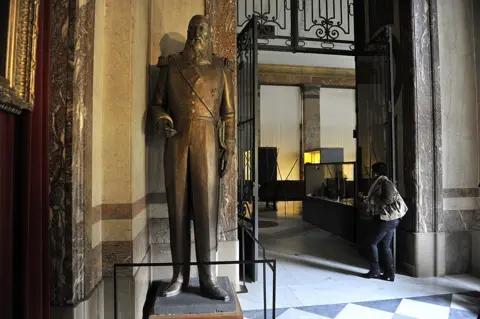 Getty Images
Getty ImagesBefore a renovation in 2018, Belgium's Africa Museum was known as the world's "last colonial museum"
Last week thousands in the country of 11 million joined solidarity protests about the killing of US black man George Floyd in police custody.
A renewed global focus on racism is highlighting a violent colonial history that generated riches for Belgians but death and misery for Congolese.
"Everyone is waking up from a sleep, it's a reckoning with the past," explains Debora Kayembe, a Congolese human rights lawyer who has lived in Belgium.
Statues defaced and removed
Like statues of racist historical figures vandalised or removed in Britain and the US, Leopold II's days on Belgian streets could now be numbered.
On Monday the University of Mons removed a bust of the late king, following the circulation of a student-led petition saying it represented the "rape, mutilation and genocide of millions of Congolese".
Joëlle Sambi Nzeba, a Belgian-Congolese poet and spokesperson for the Belgian Network for Black Lives, says the statues tell her she is "less than a regular Belgian".
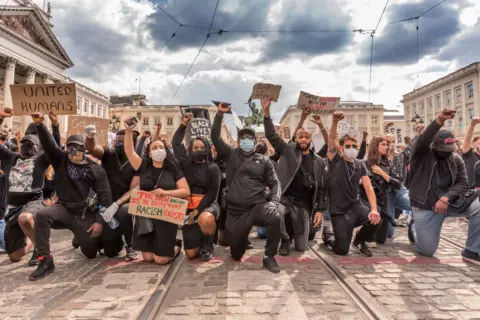 Getty Images
Getty ImagesThousands marched in Black Lives Matter protests in Belgium
"When I walk in a city that in every corner glorifies racism and colonialism, it tells me that me and my history are not valid," she explains from the capital.
For activists the holy grail is the giant statue of Leopold II on horseback at the gates of the Royal Palace in Brussels. A petition calling on the city for its removal has reached 74,000 signatures.
"I will dance if it comes down. I never imagined this happening in my lifetime," Ms Kayembe adds. It would be "really significant for Congolese people, especially those whose families perished," she explains.
She does not believe it will not be quick or easy. There are at least 13 statues to Leopold II in Belgium, according to one crowd-sourced map, and numerous parks, squares and street names.
Warning: This piece contains graphic pictures
One visitor to the Africa Museum, where an outdoor statue was defaced last week, disagreed with the idea of removing them - "they're part of history," he explained.
A king who still commands praise
On Friday the younger brother of Belgium's King Philippe, Prince Laurent, defended his ancestor saying Leopold II was not responsible for atrocities in the colony "because he never went to Congo". The royal palace is yet to give its own response.
For many years Leopold II was widely known as a leader who defended Belgium's neutrality in the 1870-71 Franco-Prussian war and commissioned public works fit for a modern nation.
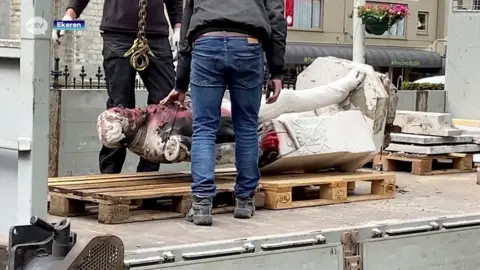 Reuters
ReutersThis TV image shows a statue of Leopold defaced and damaged by fire being removed in Antwerp
In 2010, former Belgian foreign minister Louis Michel and the father of future prime minister Charles Michel, called Leopold "a hero with ambitions for a small country like Belgium".
In a TV debate this week, a former president of the Free University of Brussels, Hervé Hasquin, argued there were "positive aspects" to colonisation, listing the health system, infrastructure, and primary education he said Belgium brought to Central Africa.
Colony built on forced labour and brutality
"Civilisation" was at the core of Leopold II's pitch to European leaders in 1885 when they sliced up and allocated territories in what became known as the Scramble for Africa.
He promised a humanitarian and philanthropic mission that would improve the lives of Africans.
 Getty Images
Getty ImagesColonial officials amputated and mutilated Congolese people, including children, as punishment
In return European leaders, gathered at the Berlin Conference, granted him 2m sq km (770,000 sq miles) to forge a personal colony where he was free to do as he liked. He called it Congo Free State.
It quickly became a brutal, exploitative regime that relied on forced labour to cultivate and trade rubber, ivory and minerals.
Archive pictures from Congo Free State document its violence and brutality.
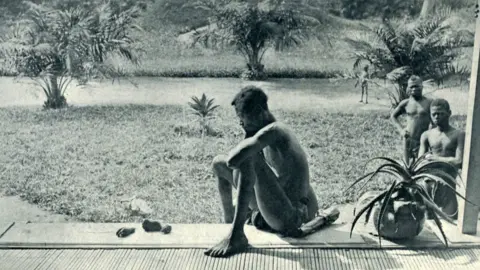 Alamy
AlamyA now infamous photo capturing atrocities committed in Congo Free State
In one, a man sits on a low platform looking at a dismembered small foot and small hand. They belonged to his five-year-old daughter, who was later killed when her village did not produce sufficient rubber. She was not unique - chopping off the limbs of enslaved Congolese was a routine form of retribution when Leopold II's quotas were not met.
Colonial administrators also kidnapped orphaned children from communities and transported them to "child colonies" to work or train as soldiers. Estimates suggest more than 50% died there.
Killings, famine and disease combined to cause the deaths of perhaps 10 million people, though historians dispute the true number.
Leopold II may never have set foot there, but he poured the profits into Belgium and into his pockets.
He built the Africa Museum in the grounds of his palace at Tervuren, with a "human zoo" in the grounds featuring 267 Congolese people as exhibits.
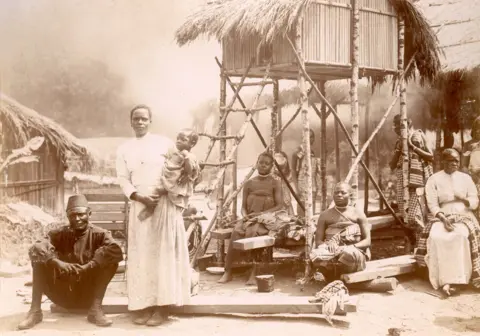 RMCA Tervuren; A. Gautier, 1897
RMCA Tervuren; A. Gautier, 1897Congolese people were forced to be human exhibits in a "zoo" in Belgium in 1897
But rumours of abuse began to circulate and missionaries and British journalist Edmund Dene Morel exposed the regime.
By 1908, Leopold II's rule was deemed so cruel that European leaders, themselves violently exploiting Africa, condemned it and the Belgian parliament forced him to relinquish control of his fiefdom.
Belgium took over the colony in 1908 and it was not until 1960 that the Republic of the Congo was established, after a fight for independence.
Democratic Republic of Congo country profile
When Leopold II died in 1909, he was buried to the sound of Belgians booing.
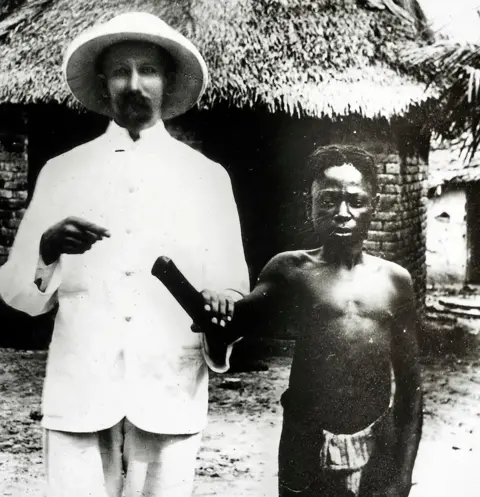 Alamy
AlamyMissionaries documented amputations while investigating abuses committed in Congo Free State
But in the chaos of the early 20th Century when World War One threatened to destroy Belgium, Leopold II's nephew King Albert I erected statues to remember the successes of years gone by.
This makeover of Leopold's image produced an amnesia that persisted for decades.
Calls for apologies
The current protests are not the first time Belgium's ugly history in Congo has been contested in the streets.
In 2019, the cities of Kortrijk and Dendermonde renamed their Leopold II streets, with Kortrijk council describing the king as a "mass murderer".
And in 2018, Brussels named a public square in honour of Patrice Lumumba, a hero of African independence movements and the first prime minister of Congo, since renamed the Democratic Republic of Congo.
 Getty Images
Getty ImagesCongolese independence hero Patrice Lumumba is commemorated in a Brussels square
Last year a UN working group called on Belgium to apologise for atrocities committed during the colonial era.
Charles Michel, prime minister at the time, declined. He did however apologise for the kidnapping of thousands of mixed-race children, known as métis, from Burundi, DR Congo and Rwanda in the 1940s and 1950s. Around 20,000 children born to Belgian settlers and local women were forcibly taken to Belgium to be fostered.
The children sent to a 'holiday camp' never to come back
What next for the statues?
Statues of Leopold II should now be housed in museums to teach Belgian history, suggests Mireille-Tsheusi Robert, director of anti-racism NGO Bamko Cran. After all, destroying the iconography of Adolf Hitler did not mean the history of Nazi Germany was forgotten, she points out.
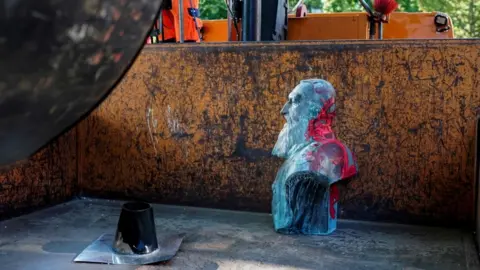 AFP
AFPThis bust of Leopold II was removed on Friday in Auderghem, near Brussels
In Kinshasa, the capital of DR Congo, Leopold II's statues were moved to the National Museum.
"Leopold II certainly does not deserve a statue in the public domain," agrees Bambi Ceuppens, scientific commissioner at the Africa Museum. But taking the monument away does not solve the problem of racism, she believes, while creating one museum devoted to the statues would not be useful either.
In DR Congo itself, no-one has really noticed the Belgian protests, says Jules Mulamba, a lawyer in the south-eastern city of Lubambashi. He attributes colonial crimes to the king himself, rather than the Belgian people or state.
Beyond removal of statues, far more work is required to dismantle racism, protesters and black communities argue.
For decades, colonial history has been barely taught in Belgium. Many classrooms still have Hergé's famous cartoon book Tintin in the Congo, with its depictions of black people now commonly accepted as extremely racist.
Belgium's education minister announced this week that secondary schools would teach colonial history from next year.
"It's a good thing that everyone is waking up, looking around and thinking 'is this right?'" says Ms Kayembe.
The children sent to a 'holiday camp' never to come back
No comments:
Post a Comment